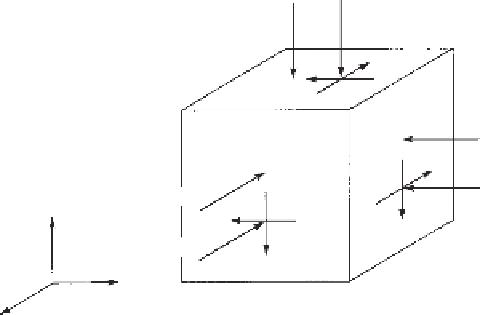Environmental Engineering Reference
In-Depth Information
the
y
-direction can be written as the difference between the
total equilibrium equation and the sum of the water, air,
and contractile skin equilibrium equations. The following
equation is obtained when using the air phase as a reference
phase during the derivation of the equilibrium equation for
the soil structure in the
y-
direction:
∂τ
xy
∂x
two independent stress tensors. The two independent stress
tensors can be written as the stress state at a point in an
unsaturated soil:
⎡
⎤
σ
x
−
u
a
τ
yx
τ
zx
⎣
⎦
τ
xy
σ
y
−
u
a
τ
zy
(3.22)
τ
xz
τ
yz
σ
z
−
u
a
∂σ
y
∂y
⎡
⎣
⎤
⎦
∂u
a
∂y
∂u
w
∂y
∂(u
a
−
u
w
)
n
c
f
∗
u
a
−
u
w
+
−
n
a
−
n
w
+
0
0
∂y
0
u
a
−
u
w
0
(3.23)
∂τ
zy
∂z
0
0
u
a
−
u
w
F
sy
F
sy
−
+
+
ρg
−
n
a
ρ
a
g
−
n
w
ρ
w
g
−
n
c
ρ
c
g
−
dx dy dz
The pore-air pressure appears in both stress tensors; how-
ever, it is the difference between stress components that
allows the two tensors to qualify as independent stress state
variables. The stress variables in Eqs. 3.22 and 3.23 can be
placed on the surface of a cube to give the stress state at a
point as shown in Fig. 3.7.
As an unsaturated soil approaches saturation, the degree of
saturation
S
approaches 100%. The pore-water pressure
u
w
approaches the pore-air pressure
u
a
and the matric suction
term
u
a
−
n
c
u
a
−
u
w
∂f
∗
∂y
+
=
0
(3.19)
where:
n
a
=
porosity with respect to the air phase,
n
c
=
porosity with respect to the contractile skin,
f
∗
=
an interaction function between the contractile
skin and the soil structure (Fredlund and Rahardjo,
1993a), and
u
w
goes toward zero. The second stress tensors
for the unsaturated soil disappear because the matric suc-
tion
u
a
−
F
sy
=
an interaction body force between the solids and
the air phase in the
y
-direction.
u
w
becomes zero. It should be noted that it is not
necessary for the pore-water pressure to go to zero in order
for the soil to behave as a saturated soil. Rather, it is neces-
sary for the pore-water pressure to increase until it becomes
equal to the pore-air pressure for the soil to behave as a
saturated soil (i.e., a two-phase system).
Once pore-water pressure is equal to pore-air pressure,
only the first stress tensor is left to represent the stress state
for a saturated soil. The pore-air pressure term in the first
stress tensor becomes equal to the pore-water pressure
u
w
as the soil becomes saturated. The stress state at a point in a
saturated soil is illustrated in Fig. 3.8. The stress tensor for
a saturated soil is consistent with that presented by Terzaghi
(1936) as the effective stress variable
σ
Similar equilibrium equations can be written for the
x-
and
z-
directions, respectively:
∂σ
x
∂x
∂τ
yx
∂y
∂u
a
∂y
∂u
w
∂y
∂(u
a
−
u
w
)
n
c
f
∗
+
−
n
a
−
n
w
+
∂y
dx dy dz
u
w
)
∂f
∗
∂y
∂τ
zx
∂z
F
sx
+
F
sx
−
+
−
n
c
(u
a
−
=
0
(3.20)
∂τ
xz
∂x
∂τ
yz
∂y
∂u
a
∂y
∂u
w
∂y
∂(u
a
−
u
w
)
n
c
f
∗
+
−
n
a
−
n
w
+
∂y
−
u
w
.
dx dy dz
u
w
)
∂f
∗
∂y
∂σ
z
∂z
F
sz
+
F
sz
−
+
−
n
c
(u
a
−
=
0
(3.21)
The stress variables controlling the equilibrium of the
soil structure are the stress state variables that control the
mechanical behavior of soils. Fredlund and Morgenstern
(1977) also showed that the stress variables controlling the
equilibrium of the soil structure were the same as those
controlling the equilibrium of the contractile skin.
There are three independent sets of normal stresses (i.e.,
surface tractions) that can be extracted from the equilibrium
equations for the soil structure to form the stress state vari-
ables. The three stress state variables are
σ
s
y
u
a
u
a
−
u
w
−
t
yx
t
yz
u
a
−
u
w
t
xz
s
x
−
u
a
u
a
−
u
w
t
zx
t
xy
y
u
w
,
and
u
a
. The stress variable
u
a
can be eliminated if the soil
particles are assumed to be incompressible. Therefore, the
stress state variables for the soil structure and the contractile
skin in an unsaturated soil are
σ
−
u
a
,
u
a
−
s
z
−
u
a
t
zy
x
z
u
w
.
The stress state variables act in three Cartesian coordi-
nate directions and the variables can be collected to form
−
u
a
and
u
a
−
Figure 3.7
Stress state at point based on surface tractions
extracted from soil structure force equilibrium equations for unsat-
urated soil (i.e.,
x-, y-,
and
z-
directions).













Search WWH ::

Custom Search